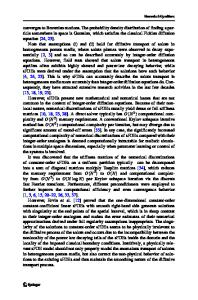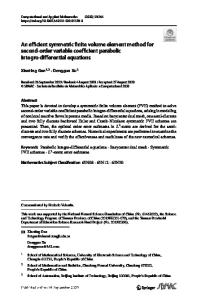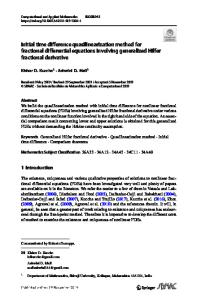A Finite Difference Method for Space Fractional Differential Equations with Variable Diffusivity Coefficient
- PDF / 2,394,939 Bytes
- 18 Pages / 439.37 x 666.142 pts Page_size
- 26 Downloads / 352 Views
A Finite Difference Method for Space Fractional Differential Equations with Variable Diffusivity Coefficient K. A. Mustapha1 · K. M. Furati1 · O. M. Knio2 · O. P. Le Maître3 Received: 2 December 2019 / Revised: 6 February 2020 / Accepted: 14 March 2020 © Shanghai University 2020
Abstract Anomalous diffusion is a phenomenon that cannot be modeled accurately by second-order diffusion equations, but is better described by fractional diffusion models. The nonlocal nature of the fractional diffusion operators makes substantially more difficult the mathematical analysis of these models and the establishment of suitable numerical schemes. This paper proposes and analyzes the first finite difference method for solving variable-coefficient onedimensional (steady state) fractional differential equations (DEs) with two-sided fractional derivatives (FDs). The proposed scheme combines first-order forward and backward Euler methods for approximating the left-sided FD when the right-sided FD is approximated by two consecutive applications of the first-order backward Euler method. Our scheme reduces to the standard second-order central difference in the absence of FDs. The existence and uniqueness of the numerical solution are proved, and truncation errors of order h are demonstrated (h denotes the maximum space step size). The numerical tests illustrate the global O(h) accuracy, except for nonsmooth cases which, as expected, have deteriorated convergence rates. Keywords Two-sided fractional derivatives · Variable coefficients · Finite differences Mathematics Subject Classifcation 26A33 · 35R09 · 65M06 · 65M15
1 Introduction This work aims at constructing and analyzing a finite difference scheme for solving onedimensional two-sided conservative fractional order differential equations with the variable coefficient, 𝜅 , of the form ( ) A𝛼,𝜃 u(x) ∶= −𝜕x 𝜅(x)𝜕x𝛼,𝜃 u(x) = f (x) for x ∈ Ω ∶= (a, b) (1) * K. A. Mustapha [email protected] 1
Department of Mathematics and Statistics, King Fahd University of Petroleum and Minerals, Dhahran 31261, Kingdom of Saudi Arabia
2
Computer, Electrical, Mathermatical Sciences and Engineering Division, King Abdullah University of Science and Technology, Thuwal 23955, Kingdom of Saudi Arabia
3
CNRS, LIMSI, Université Paris-Saclay, Campus Universitaire ‑ BP 133, 91403 Orsay, France
13
Vol.:(0123456789)
Communications on Applied Mathematics and Computation
subject to absorbing boundary conditions u = 0 on ℝ�Ω and so u(a) = u(b) = 0 . Here, 𝛼 ∈ (0, 1) is the fractional order exponent, and 𝜅 is the generalized diffusivity coefficient satisfying the positivity assumption c0 ≤ 𝜅(x) ≤ c1 on Ω for some positive constants c0 and c1 . For the truncation error analysis, we assume that f ∈ C1 (Ω) and 𝜅 ∈ C2 (Ω) . In (1), 𝜕x denotes the first-order derivative, and the two-sided fractional order differential operator 𝜕x𝛼,𝜃 ∶= 𝜃 a D𝛼x + (1 − 𝜃)x D𝛼b . Here, 0 ≤ 𝜃 ≤ 1 is a parameter describing the relative probabilities of particles to travel ahead or behind the mean displacement, a D𝛼x and x D𝛼b a
Data Loading...











